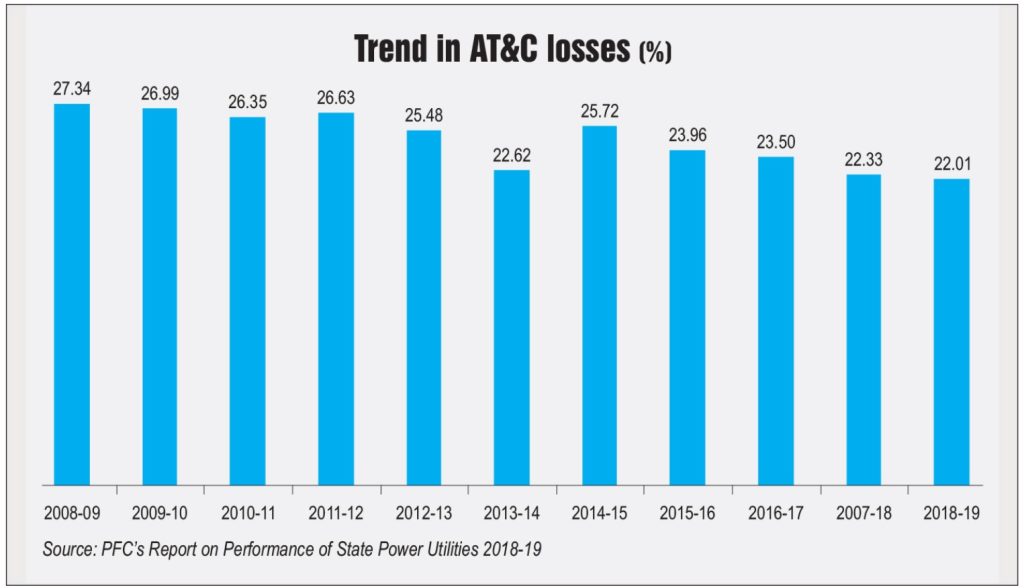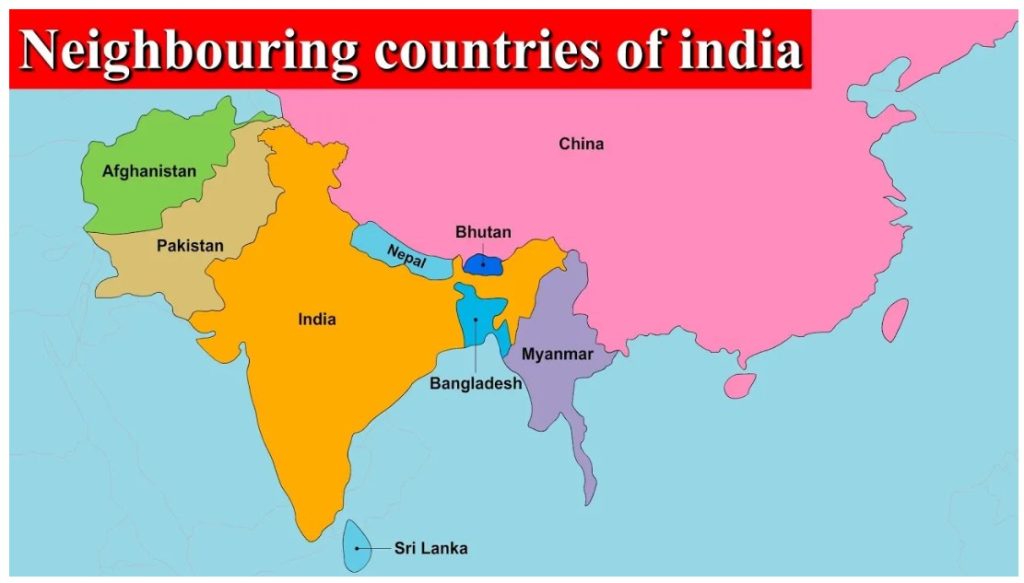CONTENTS
- Populism Cripples Revival of Discoms
- Government Must Reboot its ‘Neighbourhood First’ Policy
Populism Cripples Revival of Discoms
Context:
The Central Government is planning to introduce another scheme aimed at helping public sector power distribution utilities (discoms) reduce technical losses through “transition financing” for the necessary capital expenditure. Discoms, which are primarily owned and managed by State Governments, play a crucial role in the power supply and distribution network.
Relevance:
- GS2- Government Policies & Interventions
- GS3- Growth & Development
Mains Question:
What are the major concerns associated with the power sector in India? Also suggest a way forward strategy to enhance the efficiency of the power sector. (15 Marks, 250 Words).
Working of Discoms and Technical Losses:
- Discoms purchase electricity from public sector generating companies (gencos) like National Thermal Power Corporation (NTPC) and from private sector independent power producers (IPPs) to supply to consumers.
- Technical losses, more precisely referred to as aggregate technical and commercial (AT&C) losses, represent leakage from the system or power theft.
- According to Union Power Minister RK Singh, AT&C losses were previously as high as 27 percent. This means that out of every 100 units of electricity generated, 27 units are stolen and unpaid for, significantly impacting the discoms’ operations.
- To compensate for the revenue lost on these 27 stolen units, discoms could theoretically increase the price of the remaining 73 units.
- However, in practice, this is not feasible, leading to losses equivalent to the revenue from the stolen units. Additionally, there are other factors that worsen their financial situation.
Other Factors Straining the Discoms’ Finances:
- The Electricity Act (2003) and the Guidelines from the Ministry of Power require discoms to set electricity tariffs such that the average revenue realization (ARR) matches the average cost of supply (ACS), including purchase, transmission, and distribution.
- Despite this, State Government directives often lead to certain households being billed either nothing (for consumption up to 200/300 units a month in Delhi/Punjab) or receiving a flat subsidy (₹800 for consumption between 201 and 400 units a month in Delhi).
- Moreover, there is free electricity supply to farmers in Punjab, further straining the discoms’ finances.
- Discoms attempt to offset under-recoveries by increasing tariffs for industries and businesses, sometimes up to ₹16 per unit.
- This high cost is a significant factor in making Indian products and services less competitive both domestically and internationally.
- Although States promise to compensate for much of the under-recoveries, they often provide only partial reimbursements and do so after considerable delays, exacerbating discoms’ financial losses.
- The twin challenges of AT&C losses and under-recoveries from sales to households and farmers have persisted for nearly 25 years.
Central Government’s Financial Restructuring Packages:
- Since the early 2000s, the Central Government has introduced four financial restructuring packages (FRPs) to assist discoms.
- The first two packages (2002, 2012) mainly aimed at writing off their losses.
Ujwal DISCOM Assurance Yojana (UDAY)- The Third Package:
About:
- The third package, Ujwal DISCOM Assurance Yojana (UDAY), launched in November 2015, required discoms to meet specific milestones in exchange for financial aid.
- Under UDAY, discoms’ massive debt of approximately ₹400,000 crore was addressed. States took over 75 percent of this debt, and for the remaining amount, discoms were permitted to issue bonds at a concessional interest rate.
- In return, discoms were expected to reduce AT&C losses from 20.7 percent in 2015-16 to 15 percent by 2018-19 and to eliminate the ACS-ARR gap, which was ₹0.59 per unit in 2015-16, by 2018-19. However, discoms failed to meet these targets.
Progress Achieved:
- In 2019-20, their AT&C losses were 18.9 percent, missing the 15 percent target for 2018-19. The ACS-ARR gap was ₹0.42 per unit, against a target of zero for 2018-19. During 2020-21, the situation worsened, with AT&C losses rising to 22.3 percent and the ACS-ARR gap increasing to ₹0.69 per unit.
- Consequently, discoms’ losses, which had reduced from ₹52,000 crore in 2015-16 to ₹17,000 crore in 2017-18 due to the FRP, surged to about ₹30,000 crore in 2019-20 and further to ₹58,000 crore in 2020-21.
- As a result, their debt ballooned, reaching ₹620,000 crore by the end of FY 2021-22.

‘Reforms-Linked, Result-Based Scheme for Distribution’ (RLRBSD)- The Fourth Package:
About:
- In response, the Central Government introduced a fourth package called the ‘Reforms-Linked, Result-Based Scheme for Distribution’ (RLRBSD), announced by Finance Minister Nirmala Sitharaman in the FY 2021-22 Budget.
- With an outlay of ₹300,000 crore, the scheme aims to reduce discoms’ AT&C losses to 12-15 percent and eliminate the ACS-ARR gap by March 2025.
- This goal is to be achieved by upgrading distribution infrastructure and building capacity to enhance the reliability and quality of power supply.
- The scheme includes a mandatory component for pre-paid and smart metering across the power supply chain, including approximately 220 million households.
- In addition to nearly ₹100,000 crore in gross budgetary support (GBS) from the Centre, the scheme involves funding from state-run sector-specific lenders such as the Power Finance Corporation (PFC) and Rural Electrification Corporation (REC) under irrevocable State Government guarantees.
- The release of funds is contingent on discoms meeting pre-qualifying criteria and achieving basic reform benchmarks.
- The RLRBSD, launched in FY 2021-22, sets targets that were originally supposed to be met by 2018-19, now aiming for March 2025—a goal that some find laughable.
Progress Achieved:
- Regarding progress, the Power Ministry has identified 57 discoms from 32 States and Union Territories under the scheme and prepared detailed project reports (DPRs) for these.
- According to a statement by then Power Minister RK Singh in December 2023, DPRs totaling ₹120,000 crore have been approved for loss reduction works, and ₹130,000 crore for smart metering works.
- Beyond the paperwork, as of January 2024, PFC-REC has disbursed a total of ₹112,000 crore in loans to 16 States under the scheme, with the sanctioned amount standing at ₹133,000 crore.
- Regarding gross budgetary support, the Centre released only ₹6,000 crore in FY 2023-24, half of the ₹12,000 crore budget allocation.
- Progress has been slow; for instance, out of the sanctioned 220 million smart meters, only about 0.8 million have been installed so far.
- There is concern that discoms might be using the funds to repay earlier loans used to cover recurring losses, similar to what happened under UDAY.
- With the scheme set to end in about 10 months on March 31, 2025, the Government plans to launch a second version, RLRBSD-II, with a similar outlay of ₹300,000 crore.
- However, there’s a risk that these funds might also be used to manage the growing debt of discoms, perpetuating the cycle of financial distress.
Conclusion:
Apart from the above concerns what needs to be comprehended is that the root of the problem is political. To win elections, which occur frequently, almost every political party offers populist measures such as heavily subsidized or free power to farmers and poor households, and often overlooks power theft in slums that provide significant votes. They use discoms as tools to achieve these populist goals.
Government Must Reboot its ‘Neighbourhood First’ Policy
Context:
The presence of leaders from nearby nations and the Indian Ocean region at the Indian Prime Minister’s third-term inauguration underscores the importance New Delhi places on these relationships. The government of the day must prioritize efforts to reclaim neighboring countries that have aligned more closely with China.
Relevance:
GS2-
- Bilateral, Regional and Global Groupings and Agreements involving India and/or affecting India’s interests.
- Effect of Policies and Politics of Developed and Developing Countries on India’s interests, Indian Diaspora.
Mains Question:
The government’s top priorities should include strengthening of bilateral ties with neighbours and heralding a new era of dialogue to counter China’s influence. Discuss. (10 Marks, 150 Words).
Leaders at the Ceremony:
- Prominent attendees included Bangladesh Prime Minister Sheikh Hasina and Sri Lankan President Ranil Wickremesinghe.
- The ceremony also saw the participation of Bhutan Prime Minister Tshering Tobgay, Nepal Prime Minister Pushpa Kamal Dahal, Mauritius Prime Minister Pravind Kumar Jugnauth, Seychelles Vice-President Ahmed Afif, and Maldives President Mohamed Muizzu.
- Muizzu’s inclusion is viewed as a strategic diplomatic move, especially given the current tensions between India and the Maldives.
- It is worth noting that leaders from the eight SAARC member states were invited to in the 2014 swearing-in, and leaders from BIMSTEC, Mauritius, and Kyrgyzstan for the 2019 inauguration.
Pressing National and International Issues:
- The administration faces a multitude of pressing national and international issues that require immediate strategic planning and action.
- Experts suggest that India must address the US threat to impose sanctions if the Chabahar Port deal with Iran is not abandoned.
- Interestingly, the US did not object to India’s construction of the port when it was beneficial during its occupation of Afghanistan, but now that the US has withdrawn, it shows no interest in the port.
Managing A Coalition Government:
- Former Prime Minister Jawaharlal Nehru’s Indian National Congress achieved a significant victory in 1962, securing 44.7% of the vote and winning 361 out of 494 seats.
- In contrast won 238 seats out of 543, with the NDA collectively securing 294 seats. Unlike the BJP, which depends on coalition partners, the Congress under Nehru stood independently strong.
- This situation isn’t unique to India; in Britain, leaders such as Margaret Thatcher and Tony Blair also secured three terms.
- However, managing a coalition government with a slim majority presents unique challenges, as the reduced strength increases the bargaining power of smaller coalition partners.
The Government’s Foreign Policy:
The Modi government’s foreign policy has alienated neighbors like the Maldives and Nepal, necessitating a reevaluation as they drift towards China, which seeks to expand its influence.

- Regarding Pakistan, India should consider engaging in trade talks while setting aside political issues, as the Sharif brothers might be open to this.
- China’s growing regional influence, evident in its relationship with Nepal, requires cautious countermeasures from India.
- The recent political shift in Nepal towards a communist government aligned with China is particularly concerning, especially in light of China’s ‘Debt Trap’ strategy.
- Pakistan exemplifies this issue, having received a massive $23 billion debt from China, much of which is tied to the Belt and Road Initiative.
- Pakistan’s total debt to China, amounting to $67.2 billion from 2000 to 2021, highlights the risks of such dependency.
- India should be concerned as the Maldives has already moved closer to China, and Nepal, under the communist government led by Pushpa Kamal Dahal ‘Prachanda,’ has shown similar tendencies.
Conclusion:
The current government is expected to be in office for the next five years from a relatively weakened position, but he remains determined to pursue economic reforms to establish India as a global power. In this context, the Opposition is expected to play a constructive role in the interest of the country’s people.




